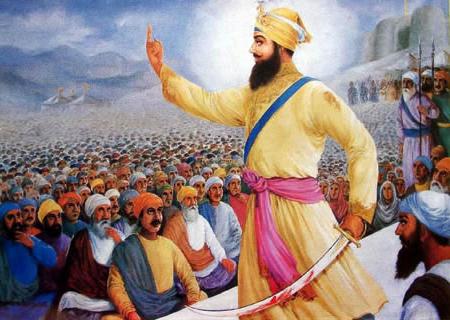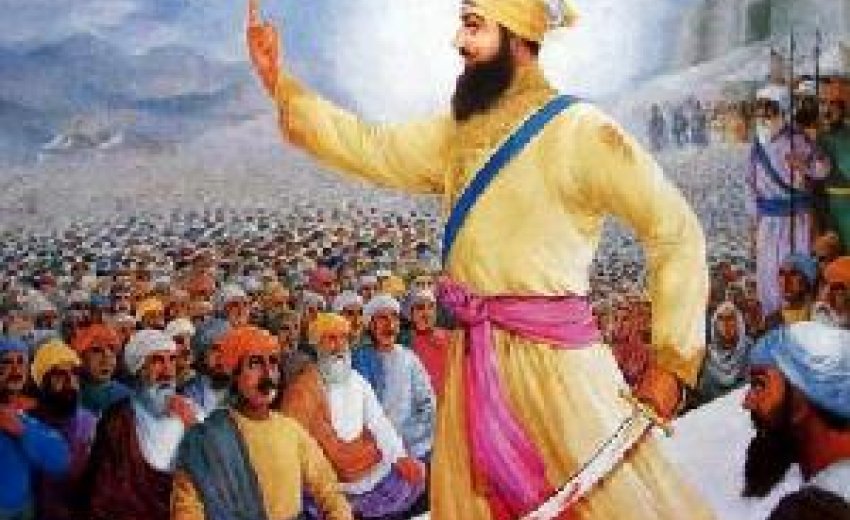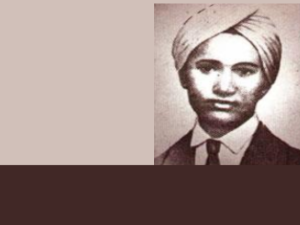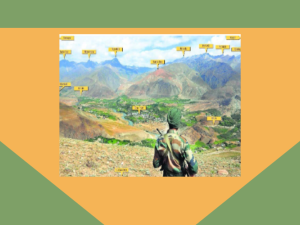The key elements of real empowerment emerge as equality, participation, access to opportunities, sharing of resources and influencing decisions both at psychological, political and community level. These elements have been considered here as the basis for analysing the Khalsa concept of empowerment.
Khalsa derives from Arabic ‘khalis’ (lit. pure, unsullied) and Perso-Arabic ‘khalisah’ (lit. pure; office of revenue department; lands directly under government management). The term 'khalisah' was used during the Muslim rule in India for ‘crown lands administered directly by the king without the mediation of landlords’ (jagirdars or mansabdars). In Sikh history, this word is first found recorded in Sri Guru Granth Sahib (SGGS) in the hymn of Saint Kabir meaning ‘pure’. Among the Sikh Gurus, Guru Hargobind (1595-1644) used it first in his epistle (hukamnama) stating ‘poorv ki sangat Guru ka Khalsa hoi’ (The congregation of the East should become ‘Guru ka Khalsa’(Guru’s own or Guru’s special charge or directly administered by Guru). Guru Tegh Bahadur also used this word in his ‘hukamnama’ to the ‘Sangat’ (congregation) of Patna. Guru Gobind Singh used this word first in a hukamnama on March 12, 1699 addressed to the Sangat of Machhiwara just before the historic Vaisakhi of 1699. In this Hukamnama he specially instructed the Sangat not to accept masands (representatives of the Guru). On the historic Vaisakhi of 1699 A.D., he used the word Khalsa for the amrit-blessed Sangat. In almost all his later hukamnamas, the Guru used the world Khalsa to connote as Guru’s Own/The Lord’s own. Anointing of Sikh Sangat as Khalsa by Guru Gobind Singh is recorded by the Bhatts of Guru’s darbar. ‘On the Sangrand of Vaisakh 1755 (30 March, 1699 A.D.) at Anandpur in a congregation of 80,000 devotees, Guru Gobind Singh came out on the dais with a naked sword and demanded for a Sikh to offer himself for sacrifice. It caused deathly silence among the people and a fear gripped many. It was Daya Ram Sobti Khatri from Lahore who came out to offer himself for the sacrifice. He showed no fear of death at the hands of the Guru as he himself was totally committed to the Guru and his ideals. As he led, four more Sikhs, Mohkam Chand of Dwarka, tailor by trade, Sahib Chand of Bidar, (Karnatak,) barber by trade, Dharam Chand of Hastinapur, (Uttar Pradesh,) and a farmer by trade and Himmat Chand of Jagannath Puri, (Orissa) water carrier by trade, followed and offered themselves for the sacrifice one after the other. After the bath they were given five K’s - (Kangha (a wooden comb) for the Kesh (hair), Sarb Loh Kada (an iron bracelet) for the wrist, Kachha (a pair of short breeches) and Kirpan (a sword in a cloth belt) to be worn along with a kesri dress and double blue head-dress. Guru too wore the same dress and came, along with these five, on the dais in front of the congregation, surprising everyone present.
Anointing of Sikh Sangat as Khalsa by Guru Gobind Singh is recorded by the Bhatts of Guru’s darbar. ‘On the Sangrand of Vaisakh 1755 (30 March, 1699 A.D.) at Anandpur in a congregation of 80,000 devotees, Guru Gobind Singh came out on the dais with a naked sword and demanded for a Sikh to offer himself for sacrifice. It caused deathly silence among the people and a fear gripped many. It was Daya Ram Sobti Khatri from Lahore who came out to offer himself for the sacrifice. He showed no fear of death at the hands of the Guru as he himself was totally committed to the Guru and his ideals. As he led, four more Sikhs, Mohkam Chand of Dwarka, tailor by trade, Sahib Chand of Bidar, (Karnatak,) barber by trade, Dharam Chand of Hastinapur, (Uttar Pradesh,) and a farmer by trade and Himmat Chand of Jagannath Puri, (Orissa) water carrier by trade, followed and offered themselves for the sacrifice one after the other. After the bath they were given five K’s - (Kangha (a wooden comb) for the Kesh (hair), Sarb Loh Kada (an iron bracelet) for the wrist, Kachha (a pair of short breeches) and Kirpan (a sword in a cloth belt) to be worn along with a kesri dress and double blue head-dress. Guru too wore the same dress and came, along with these five, on the dais in front of the congregation, surprising everyone present.
The Guru addressed the congregation, "Dear Sikhs, in the trial of Guru Nanak only one Sikh Bhai Lehna (Guru Angad) passed the test and Guru Nanak embraced him and gave the name Angad. This time these five Sikhs have passed the test of sacrifice. I give them the position of ‘Panj Piare’ (The Beloved Five). They shall be ever remembered so. …..The Guru then addressed himself to Bhai Chaupat Rai and said, "Brother Sikh ! Take this pot-ful of charn-pahul (nectar prepared by touch of foot) and clear it off in the River Satluj. Returning, you collect the fresh water of the river; I am to prepare pahul of double-edged sword (Khande di pahul). Guru ji asked Diwan Dharam Chand to bring a stone-pestle (koonda), an iron pan (batta) and a double -edged sword (khanda). Guru ji poured the water of Satluj in the iron pan in front of Bhai Daya Ram and others and stirred the water, reciting Japu Ji Sahib first..... Mata Sahib Kaur ... poured the sugar plums (patasas) into the iron pan. The Guru understood the feelings of Mata Ji but without looking up and losing his concentration, continued reciting Japu Ji, followed by the recitation of Jaap, Sawaie,Chaupai and Sri Anand Sahib. As the ‘nectar’ was ready, he stood and prayed to the Lord and gave a winning call, ‘Nanak says: Name of the Lord will always be in the ascendancy and His Will is blessing for the entire humanity.’
He then put a drop on the edge of the ‘khanda’(two-edged sword), put five drops into his own mouth and called ‘Waheguru ji ka Khalsa, Waheguru ji ki Fateh’ (Hail the Khalsa who belongs to the Lord! Hail the Lord to whom belongs the victory!) five times. He explained the importance of khanda stating: "It is the same khanda given to him by the Mahankal (The Timeless Lord) after his meditation at Hemkunt, from which I am giving you the ‘Khande di pahul ’. You must keep symbol of this ‘khanda’ under the small turban. You will always succeed in every field by its blessings."
The Guru then explained all the tenets of Khalsa Panth and said, "All your past life record, religion, deeds, superstitions and shame are now gone. You have been made Khalsa, the form of the Lord (Sargun Sarup Ka:l). You must preserve its honour. Before giving you pahul, you have been given five K’s (Kes, Kangha, Kada, Kachha, Kirpan); never separate these from your body even by mistake.... If you ever separate even one of them, go to Gurudwara and get your mistake rectified post-haste with the permission of the sangat …. Except the Timeless Lord, do not worship mathh, tomb, or grave. I have united you all in the iron pan, hence never keep differences and doubts among yourself."
He further described the details of Khalsa Rahet Maryada (Code of Conduct/ discipline) and said, " O Brother Sikhs! Neither cause fear in nor be afraid of anyone. Keep faith in the Only One Timeless Lord — He will help you every where. Always earn your living through hard work….. Recite the Lord’s name and guide others to recite. Read and teach Bani (Guru’s hymns) and go to the congregation at the twilight…. After teaching Gurmukhi to your children, provide them the other education, from wherever it is available and should have no doubts. Go to Gurdwara twice i.e., in the morning and evening; give the winning call of the Lord (Waheguru Ji Ka Khalsa Waheguru Ji ki Fateh) with folded hands; do not take anything without paying obeisance to the Sangat."
From the above events following facts emerge:
- Spirit of Sacrifice: Offering self as sacrifice denotes total commitment to the cause and the Guru.
- Shedding all Fear: He removed fear of death by setting examples of The Beloved Five and named them ‘Singhs’. He armed them with sword and gave them strength of unity through common brotherhood maintaining no differences among themselves. He asked them to believe in One and the Only Lord and to fear no one.
- Exemplary Motivation: He motivated his followers so strongly that they came to offer their lives voluntarily for sacrifice and the masses accepted baptism in a spirit to rise together against the oppression and tyranny and to establish an independent authority.
- Rejuvenation through Amrit: The Guru converted Sikhs from saints to saint-soldiers. And wedded ‘bhakti’ (meditation) and ‘shakti’ (power) through Khande di pahul. He gave a new hope and strength and resuscitated the dying spirit of the masses who had given up in the face of oppression and tyranny and timidly accepted their fate.
- Arming for defence: He armed the Sikhs in an order to protect themselves as he found that this was a course of last resort to confront tyranny and oppression.
- Collective leadership: The concept of ‘panj piara’ and decision making by sangat and sangat as Khalsa, all these were the new systems for inculcating the spirit of collective leadership.
- Welfare of Mankind: He kept the welfare of entire mankind (Sarbat ka bhala) as his chief motive. He created Khalsa for the future betterment of the people.
- Purity of character: Guru Gobind Singh defined the term ‘Khalsa’ as ‘The Lord’s Own’ (Waheguru Ji ka Khalsa). He explained, ‘the Khalsa will be called pure only when he believes and worships the One and the Only Lord and none else.’ This purity became the root of fearlessness, equality, justice and fraternity.
- Discipline through a Common Code of Conduct and Common Identity: The first Sikhs who offered themselves for sacrifice to the Guru belonged to all the corners of India, representing high and low, rich and poor, and almost all key castes, i.e., so-called untouchables and the Brahmins. The Guru welded all into one removing all disparities, distinctions and identities through Pahul and called them the Singhs and the Khalsa. He merged his own identity too into the Khalsa and called them as brothers. He wore the same dress as prescribed to the newly baptised Singhs. He shed his supremacy by bowing before the five and quaffing pahul at their hands. He created Khalsa symbols and methodologies to depict independent identity of the Khalsa.
- Sangat: He emphasised the role of Sangat (congregation) in Sikhism. The congregation could get together at any Gurdwara (Sikh religious place) or at any other suitably chosen place and recite True Lord’s name(Waheguru) without any barrier of caste, creed, colour, sex, region and religion. This not only ensured equality of all but encouraged mass participation. The decision making was to be unanimous. Anyone could raise his point of view without fear or restriction. Any one’s point could form the basis of decision. Thus, anyone could influence the decisions and all had equal opportunities.
- Pangat: The Guru instituted imparting of ‘khande ka pahul’ in a row. He also emphasised on a free community kitchen ‘Guru ka langar’ where all sat and ate together in the same row (Pangat) regardless of distinctions of caste, creed, status or sex in life. The Hindus and Muslims , the Brahmins and the Sudras were thus brought to a common social level.
- Common Brotherhood: The Guru called the newly anointed "Singhs" as ‘Bhai’(brother). All the Khalsa was declared as one brotherhood. The Guru said, "I have mixed you all in the Steel pan. There should be no difference among you all."
- Establishment of an ideal social and economic order:- The Guru brought the Sikhs to the centre-stage from the background and inducted them to be their own masters and the undaunted decision makers in conformity with the specified disciplinary code. The inherent and essential unity of the manifest phenomena with Creator Lord also implicitly supports the spiritual unity, ethnic equality and social equity of the entire mankind. All external differences, between man and man are only superficial caused by the difference of the respective places and climes they live in. Inherently they are all one - not only with the Creator but also among themselves creating universal brotherhood of mankind
Coming as it does from the universal fatherhood of God, brotherhood leads further to the cultivation of values like mutual love and compassion, understanding and altruism, harmony and coexistence, religious pluralism and democracy, without which the entire theological and metaphysical structure is bound to collapse. Communal harmony and co-existence with common-brotherhood among all was the basis of the new social structure. The basic qualities ingrained in this social and economic order were unity and strength, participation of masses without barriers, equal access to opportunities, sharing of resources, social justice and ability to influencing decisions.
The psychological upliftment through motivation, collective leadership, removal of fear of death, insecurity, distinctions and disparities and inculcating in them the spirit of self-defence caused an electric effect. Their social acceptance at an equal standing and sudden feeling of political and economic strength made them feel empowered in real terms. If we delve into historical past, we will find that this was not a result of an overnight reaction or of a single cause, but the result of a long evolutionary process, which started with Guru Nanak (1469-1539), the first Guru of the Sikhs. Indeed Guru Nanak was a revolutionary religious and social reformer according to whom the political and cultural domination of the people by the ruling and priestly classes was chiefly responsible for their degeneration. He found the political scene very disturbing and wrote " Kings are predators and their underlings greedy as dogs; they oppress the people day and night."
In this situation, Guru Nanak thought the emancipation of the people could only be brought about by a new consciousness which instils into them equality and dispels all fear.
He proclaimed that all men and women were equal in the eyes of the Lord. He said, ‘There is only One Lord of all living-beings.’ And ‘The light of the Lord is in everyone. Every human spirit lives by His light.’
He felt that the real cause of the misery of the people was their disunity born out of diversity of belief. He sought therefore to bring them together both in thought and deed. He included a common mode of worship and a common social organisation based on the equality of man. He advocated the purity and probity of the task performed rather than the caste and said, "The caste or creed is determined by the quality of one’s actions."
Unlike many other saints and reformers, Guru Nanak did not confine himself exclusively to a life of prayer and devotion. He refused to sit idle in slumbering meditation while his people groaned under the heels of the oppressors. He awakened them to a new consciousness and upbraided the rulers of his day, saying, "Kings are butchers, relentless as a dagger. Dharma, or the sense of duty, and responsibility has taken wings and vanished."
Kings ruled with little regard to the good of the people. ‘A King’, according to him, ‘should be the dispenser of justice and righteousness.’
This was a message of hope to the people to shake off their cowardice and dependence and to ‘have faith in God, who could, in an instant, demolish the old kingly edifices and raise the lowest of the lowly to the highest pedestal.’
He travelled across Asia and delivered the message of equality, justice and fraternity. He preached that there was but One Formless, Fearless, loving Lord who belongs not to the Hindus or Muslims alone but to the entire humanity. The worship of God is not the exclusive privilege of a priestly class, nor does He belong to rulers who offer petty sums on religious activities. He is best worshipped in selfless service of humanity because He resides in everyone’s heart.
??He denounced idol-worship, blind superstition and empty rituals which had sapped religiousness and morality and parted the hearts of men from their Creator. Guru Nanak did not advocate renunciation or asceticism. Towards the end of his life he settled down with his family and sons at Kartarpur (Pakistan). He was a prophet of the people whose service to them was to create greatest happiness living in the Will of the Lord. He lived among them, shared their sorrows and sufferings, pangs and pleasures and taught them the way of honest and truthful living. ‘Truth is higher, but higher still is truthful living," said he. He wished his people to be servants of God and His people. He was held in affection not only amongst his Sikh disciples but also among his Hindus and Muslim countrymen who honoured him as a holy saint and called him Baba or father, and on his death both claimed his body and created mausoleums in their own fashions in his memory with a common wall between them- a gesture unique in the history of religions.
The teachings of the Gurus, the abolition of the dividing distinctions of caste and creed and the establishment of Sikh congregations throughout the country, with Amritsar as their "Mecca" and Granth Sahib as their Bible, made the Sikhs a living community devoted to the moral and social regeneration of the people. The spirit of service and self-sacrifice engendered by the teachings of the Gurus crystallised at the time of Guru Arjun Dev into distinct national traits.
Guru Arjun Dev attained martyrdom at the alter of his faith in 1606 A.D.. Watching the tyranny of the Mughal authority, his son Guru Hargobind (1606-1645), accorded sanction to the use of weaponry in defence of Dharma and for the protection of the oppressed. He himself wore two swords on the occasion of his succession at Akal Takht at Amritsar as emblems of spiritual and temporal authority - Peeri and Meeri- the combination of Degh and Tegh - the kettle to supply food to the needy and the sword to smite the oppressor. This was the first step towards the transformation of Sikhism into a militant church.
Mohsin Fani, a contemporary of Guru Hargobind writes in Dabistan-I-Mazahib that, "the Guru had seven hundred horses in his stables; and three hundred cavaliers and sixty artillerymen were always in his service." This was the first corps of Sikh volunteers raised by the Guru at Amritsar.
The Sikhs fought the first battle against the Mughal forces of Emperor Shah Jehan in 1628 at Gumtala on the outskirts of Amritsar. Guru Hargobind, not a soldier by design, but made so by the circumstances, from his inner-self he remained a saint; a Guru, the sixth in direct spiritual inheritance from Guru Nanak. He had taken to martial ways with a view to creating among his people a will to resistance and preparing them to stand up to the tyranny and oppression of the ruling race. Guru Hargobind’s reply to a question by the Maratha saint, Samarth Ramdas (the teacher of Shivaji Maratha) at Srinagar Garhwal in about 1634, is significant.
Fully armed and riding a horse, the Guru had just returned from a hunting excursion. Samrath Ramdas enquired: "I had heard that you occupied the seat of Guru Nanak who had renounced the world and become a saint. You are wearing arms and keeping an army and horses. You allow yourself to be addressed as the true King (sacha patshah). What sort of a sadhu are you?" Guru Hargobind replied, "Internally a hermit and externally a prince. Arms mean protection for the poor and destruction of the tyrant. Baba Nanak had not renounced the world but he had renounced ‘Maya.’ (self, ego)
Guru Hargobind’s words appealed to Samrath Ramdas who spontaneously said, "This does appeal to my mind". Samarth Ramdas realised the truth in Guru Hargobind’s words and was convinced that the tyranny of intolerant Mughals could be resisted and halted through the path described by Guru Hargobind. The visions of Guru Hargobind and Samrath Ramdas were fulfilled in the eighteenth century.
The Khalsa was thus inspired by a sense of divine mission, and no fear of an earthly power was to deflect them from their duty. A tremendous change was thus brought about in the character of the people. The lowest of the low in the society were transformed, as if by miracle, into doughty warriors who, along with the baptised Jats and Khatris, fought under the Guru’s command as many as fourteen battles; in twelve of which they were distinctly successful against the imperialist forces. When a courtier wanted to show of his superiority over the Sikhs present in Guru Darbar, Guru Gobind Singh declared the superiority of the Khalsa saying, "I won battles because of their blessing (Khalsa), it is due to their blessing that feel empowered. With their blessings all the evil runs away; with their blessing I am enlightened; with their blessing all the enemy perished. I am established due to their blessings; otherwise there are millions of poor people like me." Guru Gobind Singh thus emancipated the people from narrow identities and empowered them to be capable of deciding their own destiny.
Khalsa is "the one who recites the name of the Eternal Light day and night; whose mind does not waver from the Lord: Who has total love and devotion to Him; and does not worship grave, tomb or matths even by mistake. He does not believe in anything other than The Lord. Whose heart is enlightened by the True Eternal Light, that Khalsa must be considered pure."
Guru Gobind Singh transcended the self and aimed at the service to the entire society without any barriers of caste or creed, territory, state or language, to serve the people, who had borne the brunt of the tyranny of times. He got the vibrating support of teeming millions from all over India.
The Guru’s faith in Khalsa was total. A day before he left for heavenly abode the Guru passed on the Guruship to Sri Guru Granth Sahib and the Khalsa together. ‘The Guru took five paise and a coconut and while sitting on the cot said to Bhai Daya Singh, "Please place these in front of Sri Granth Ji." On the order of the Lord the Sikh religion was created and conducted. Every Sikh is hereby ordered that he must accept Granth as Guru. He also accept the Khalsa as Guru in whose form the Guru’s form will exist. Whosoever Sikh wants me, must search me in these two."
Thus, he declared Khalsa as his successor along with Sri Guru Granth Sahib Ji. Poet Sainapat mentioned in Sri Guru Sobha, ‘One day after the incidence (of stabbing of Sri Guru Gobind Singh by two Pathans at Nanded), the Singhs gathered and enquired, "In what form will you be hereafter? "The Guru replied that ‘Khalsa will be his form. My mission will be completed by the Khalsa. I have passed on my form on to the Khalsa’.
Khalsa was thus created from the people and for the people and consisted the community at large having faith in the principles of Sikhism. An assembled congregation, deliberating the mystic presence of the Guru, represented by the holy book Sri Guru Granth Sahib would be Khalsa. Granth-Panth became the supreme religious and secular authority of the Sikhs in all matters and at all times. Thus democratic secularisation of religion, greatly influenced the life and conduct of the Sikh people who like their spiritual Masters became the pioneers of freedom movements establishing social republics, in the form of Sikh Misls and Panchayats in Northern India.
The concepts of ‘Wahiguru Ji Ka Khalsa, Wahiguru Ji ki Fateh, Bana-bani, Naam di chadhdi kala, Bhagti-Shakti, Granth-Panth, Khalsa ji ke bol bale, Sarbat Khalsa, sarbat da bhala, sarab-sukh, sarbat de karaj ra:s, Degh-Tegh Fateh, Sri Sahib-Bhagauti, Panj Kakar, Panj Piare and sangat-pangat, not only became the guiding principles of the Khalsa but also most of them found place in the Sikh Prayer (Ardas) and their day-to-day life.
From the study of the evolution of the Khalsa, we find that the event of Vaisakhi, 30 March 1699, was a culmination of the long drawn process in which the oppressed people were truly released from the shackles of injustice and tyranny and given a right of self-determination. They were made rulers themselves. Any number of people could get together in the form of Sangat.






